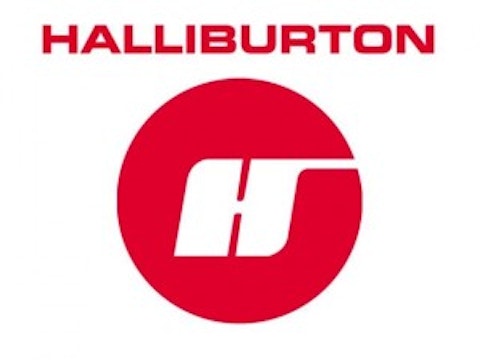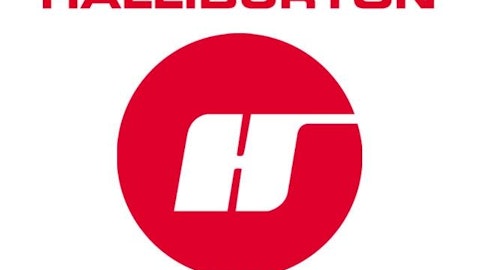
Why Halliburton
To begin with, the oilfield services industry is largely dominated by Schlumberger Limited. (NYSE:SLB), Halliburton and Baker Hughes Incorporated (NYSE:BHI). Out of these three companies, Schlumberger is the most diversified, generating around 30% of its total revenues from North America. Meanwhile Baker Hughes Incorporated (NYSE:BHI) and Halliburton Company (NYSE:HAL) are more dependent on the North American market, which accounts to 43% and 56% of their total revenues, respectively.
Thanks to the shale gas production bonanza, gas exploration activities in the continent had slowed down significantly. In fact the number of operational rigs in North America plunged to 13-year-lows last year, as oil and gas companies scrambled to break even. This was a huge blow for Baker Hughes Incorporated (NYSE:BHI) and Halliburton Company (NYSE:HAL), as they aren’t as geographically diversified as Schlumberger Limited. (NYSE:SLB).
But with the rising gas prices and depleting rigs, gas exploration in North America is gradually picking up. The management of Halliburton estimates that the North American rig count could increase by 130-170 rigs by the end of 2013. Since Halliburton is mostly leveraged towards North America, it stands out as one of the prime beneficiaries from the rebounding rig count in the region.
Subsea Advantage
It’s a well-known fact that hydrocarbon land reserves are depleting rapidly. However, oil fields beneath the ocean floor (subsea) contain huge oil and gas reserves. To explore subsea properties, specialized equipment is required that can operate in high temperatures while being submerged in sea water. And in these extreme conditions, companies must ensure that there is no leakage or spillage of toxic hydrocarbons.
Its due to this reason that very few companies offer subsea equipment and services. However, Halliburton Company (NYSE:HAL) provides a wide range of control and monitoring systems for subsea operations.
To catch up with it, Baker Hughes has launched Centrilift XP technology, which allows submersible pumps to operate in extreme conditions. The company also recently introduced its FATHOM certified chemicals, which treat waste water under on the ocean floor itself.
Meanwhile Schlumberger Limited. (NYSE:SLB) and Cameron International came together last year to form OneSubsea. Cameron International designs and manufactures subsea equipment, which will leverage Schlumberger’s global presence with its subsea expertise. But the bottom line remains that their product development will take time, which puts Halliburton Company (NYSE:HAL) in a sweet spot.
More Growth Prospects
Although Halliburton’s international segment is quite mature, its revenue share of 56% suggests that it has to work a lot towards geographical diversity. And to do this, Halliburton Company (NYSE:HAL) has been aggressively expanding abroad over the last year. On a quarterly basis, its international revenues spiked by 21% YoY, while Baker Hughes and Sclumberger posted a 6% and 30% YoY increase, respectively.
Apart from that, Halliburton is currently the leader in the fracking industry, which gives it a competitive advantage over Schlumberger and Baker Hughes. The company recently unveiled its latest fracking technology–H2Oforward–in Colorado, which reduces the waste water output by 25%.
Since offshore rigs are required to treat the toxic water before releasing into the sea, a 25% cut will significantly reduce the processing capacity for treating waste water. This will save both time and money, which is why H20Forward is being considered as the most cost effective fracking technique on the market.
Investors’ Delight
For the recent quarter, the U.S rig count was down by 3% YoY. As a result, Halliburton’s revenues from North America slid by 1% during Q1FY13 YoY. But thanks to a sequential margin improvement of 400 bps, its quarterly operating income from the region surged by 30%, while its revenues of $7 billion stood at record levels. As guar prices continue to decline, its margins are estimated to further expand by 100 bps in the next quarter.
Apart from robust financial performance, Halliburton Company (NYSE:HAL) has also been returning value to its shareholders. The company recently hiked its quarterly dividend payouts by 38%, which equates to an annual yield of 1.2%. That may still be paltry, but something is better than nothing.
The company also repurchased 1.2 million of its common shares for around $50 million during the previous quarter. Management stated that the ongoing repurchases will be accelerated during the second quarter, which will further boost its quarterly EPS growth. On April 22, Halliburton’s remaining buyback authorization stood at $1.7 billion, which allows a repurchase of 39.59 million shares, or 4.2% of its shares outstanding (at the current price).
Final words
In my opinion, all the mentioned companies have solid growth prospects to fire up their stocks. But due to the rebounding rig count in North America, Halliburton Company (NYSE:HAL) seems to have more upside potential than its peers. The company currently leads the fracking industry, offers a wide range of subsea services, and is entering new territories abroad. This should add stability to its top line over the longer run. Apart from that, Halliburton is also returning significant value to its shareholders, which altogether presents a compelling bullish case.
The article The Best Pick in the Oilfield Services Industry originally appeared on Fool.com and is written by Piyush Arora.
Piyush Arora has no position in any stocks mentioned. The Motley Fool recommends Halliburton. Piyush is a member of The Motley Fool Blog Network — entries represent the personal opinion of the blogger and are not formally edited.
Copyright © 1995 – 2013 The Motley Fool, LLC. All rights reserved. The Motley Fool has a disclosure policy.





